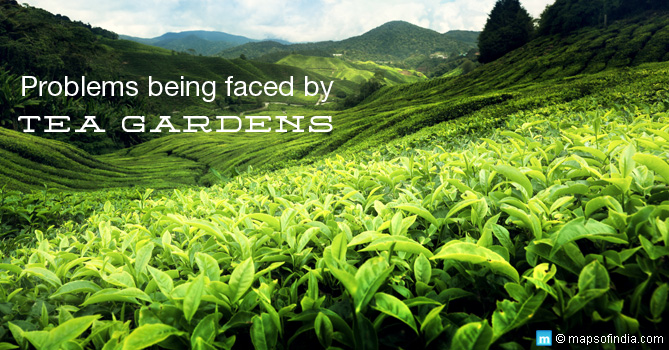In the last 200 years, the tea industry in our country has come a long way. In 1835, the first consignment was a production of 12 boxes for an auction. Today, India is the second largest producer of tea in the world.
Major tea producing states in India
Most of the tea produced in India comes from North East India, especially Assam and Tripura. The Assam tea industry accounts for more than 50% of India’s total tea production. There are 848 registered tea estates in Assam, followed by Tripura (58). Arunachal Pradesh has 5, Meghalaya has 3, Manipur 2 and Nagaland has 1 registered tea estate. In addition to the 917 registered tea gardens, there are around 10,000 small tea growers in the North East region. Darjeeling in West Bengal is another major tea producing region in the country, accounting for 25% of India’s tea output. Down South, we have the Nilgiri tea gardens and Munnar tea gardens, contributing the rest of 25% tea output.
Problems plaguing North East Tea Gardens
However, things are not so bright as it seems to be. The North East tea industry is gradually sinking due to various problems being faced by it. In fact, low wages, poor infrastructure, poor housing, health issues and lack of avenues for social mobility have been common problems since the inception of tea plantations in North East India.
Shutdowns of tea plantations
There are many tea gardens which have closed down in recent years due to various problems affecting the industry. Some of these are Red Bank, Dharanipur, Dheklapara, Surendranagar and Bundapani of the Dooars and Raipur Tea estate in West Bengal. In Assam too, many tea estates have closed down or are operating just minimally.
Causes
• Decline in tea price: Due to various causes, the auction price of the tea has seen a steady decline over the years. According to World Bank, the tea prices declined by almost 44% in real terms. In India, all the profits from the tea gardens were siphoned off and there was no real or proper reinvestment in improving quality of tea. There has been a major crisis in the Indian tea industry, which resulted in closing down of the tea gardens.
• Less production of tea: There are multiple problems being faced by the tea industry such as finance crisis, power problems, labour problems, poor labour schemes, inadequate communication system, increased revenue tax for tea gardens, increased pollution fee, less transport subsidy etc. All these have altogether put the tea industry in North East India in a hopeless situation, resulting in low production of tea leaves and tea.
• Labour demand: Leaving aside the natives, most of the workers in the tea gardens in Assam and Bengal are the ones who have migrated from states like Bihar, Orissa and Madhya Pradesh, since the later part of the 19th century. These workers are solely dependent on the tea industry for their daily income and livelihood. However, the migration of labourers has reduced in recent times, resulting in the reduction of the number of labourers in the tea factories. The local labourers have also reduced due to less number of tea labourers for NREGA.
• Sick industry: A considerable number of tea gardens have gone sick due to lack of infrastructure, modernization and efficient management.
• No proper storage: The problem of storing premium quality tea has always been there. Due to delay in transportation and lack of storage facilities, the processed tea gains moisture from the atmosphere and deteriorates in quality.
• Climatic factors: Unfavourable climatic conditions for tea plantations owing to scanty or very heavy rainfall have badly affected the tea industry.
• Pest problem: Pest problem is another major issue. Along with the mosquito bug, a disease called the bacterial black spot has also affected many plantations in North East Tea Estates.
Consequence of closing down: Starvation deaths
Between 2000 and 2015, more than 1400 people have been reported to have died in the closed tea gardens in North Bengal and North East India. The main cause of death was severe malnutrition. A majority of these deaths have taken place in Dooars tea gardens in Jalpaiguri and Aliporeduar. There are deaths in other tea estates as well but they have not been reported. The rise in the deaths has been due to closing down of a large number of tea plantations. With no alternative jobs or income, it is a daily struggle for the labourers to survive.
Major problems of labourers working in tea garden
• No permanent employment: Most of the tea garden labourers are basically from the “adivashi” community and the local people. These people are the most exploited ones in the tea gardens. Most of them work as part-time labourers as per production and requirement and peak season. A small proportion of these workers is also engaged in factory, office etc. Adult males and females are equally employed. Though child labour is not prevalent, yet in few remote gardens children are employed in plucking, weeding, hoeing, and nursery work.
• Low wages: Tea labourers are paid the lowest wages in comparison to any other labourers in the organised sector. During the peak season, tea gardens employ temporary workers at wages much lower than the actual minimum wage. Most of them act as daily waged manual workers. In big tea gardens, the workers are paid bonus during festivals and also extra amount if the output is more than required.
• Poor living conditions: One of the basic problems faced by labourers is that they have to stay in over-crowded and unhygienic living conditions in the residential colonies. They live in poor socio-economic conditions and most of these labourers remain ignorant due to illiteracy. The labourers suffer from various diseases and health problems that are mainly due to poor personal and household hygiene, poor sanitation and housing, including lack of education.
• Health problems: The poor living conditions make these labourers vulnerable to various communicable diseases. There are health problems due to poor working conditions in the tea factories. According to a research report, the major health problems faced by the labourers are worm infestation, respiratory problems, diarrhoea, skin infections, filariasis and pulmonary tuberculosis. Hypertension, epilepsy, back-pain are other health problems. There are some who suffer from underfeeding. Some health problems are due to the excessive use of alcohol and tobacco. Thinness among adults and micronutrient deficiency disorders like anemia are also prevalent. The children also suffer from under-nutrition and most of them are underweight.
• No health benefits: Under the Plantation Labour Act 1951, each tea garden should have a health centre with proper medical facilities. However, the gardens are remotely located and the health centres are located in distant towns. The workers do not have proper connectivity to these centres. There are no maternity benefit schemes available for the female tea garden workers. It has been found that women are engaged in hard jobs even during pregnancy and post natal period.





